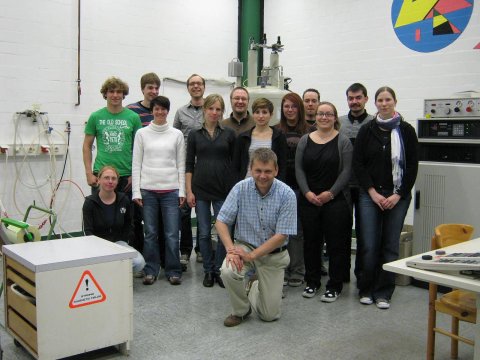Report of the 10. DMG Shortcourse "Applications of Solid State NMR Spectroscopy in the mineralogical and geoscientific research "
in Bochum from 25. - 28. May 2010

The DMG Shortcourse, in the meantime already tradition every year, took place under the direction of Michael Fechtelkord, in co-operation with the subsection spectroscopy of the DGK at the Ruhr-Universitaet in Bochum from 25.05. - 28.05.2010. It is the goal of this shortcourse to provide an overview of the basics of NMR spectroscopy and to get an impression of the experimental work as well as for the evaluation of the achieved data in four days. For this purpose 15 graduate students and Diploma students of chemistry, mineralogy/crystallography and geoscience met in that week.
The individual days contained a theory part in the morning, in which the substantial theoretical basics for the subsequent experiments were obtained. Michael Fechtelkord succeeded to provide the necessary knowledge on the basis of many descriptive illustrations and equations, without having to enter here too deeply into the physical fundamentals. So it was easy to follow without deeper previous NMR knowledge in the theoretical and practical parts, as promised in the short course advertisement. The strengths of Solid State NMR spectroscopy were brought close to the participants on the basis of simple research examples in the mineralogical research. Thus, on the first day the activation energy of methyl-group rotation in (CH3)4I by variable temperature 1H spin lattice relaxation experiments was determined. On Wednesday the magnetic dipolar and the chemical shift interaction were on the agenda. MAS NMR spectra of the nuclei 29Si, 19F and 1H were recorded of a synthetic phlogopite. The following fitting of the spectra by Lorentzian and Gaussian line shapes was done with the computer program DMNT2010. The third day took place completely against the background of multi-pulse techniques. Thus, {1H} 29Si cross polarization experiments (CPMAS) of kaolinite were accomplished and from the data H-Si distances could be computed. On the last day everything revolved around the quadrupolar interaction and their averaging with the help of different techniques. The basics of the double rotation technique (DOR), the multi-quantum magic angle spinning (MQMAS) and the Satellite Transition Spectroscopy (SATRAS) were discussed. Finally, the evaluation of the recorded 23Na MAS NMR spectra of different salts as well as a 27Al MAS NMR SATRAS spectrum was carried out in the afternoon.
Altogether this course offers a very good overview about the possibilities and limits of Solid State NMR spectroscopy during the structural investigation of inorganic solids in addition to X-ray diffraction. All participants had the opportunity to carry out different NMR experiments by themselves and to get a feeling for the experimental efforts. In addition, surely all participants stated that the evaluation of the spectra and the computation of the interesting parameters finally demands a lot of experience.
To round up the workshop programme it was accompanied by a pleasant first evening in the beer garden as well as a Bavarian bowling evening with Bavarian kitchen in Hartmann’s pub. To relax between the course blocks and to take a digesting walk at lunch time the beautiful university-own botanical garden was inviting.
Our thanks to Michael Fechtelkord, who organized and carried out this course. He answered numerous questions with much patience and tireless and was particularly during the evaluation of the data always immediately available, if there were any problems.
Hanna Lührs,
University of Bremen


